Deep wavelength radiation, particularly near-infrared light, penetrates deep into your skin's layers to jumpstart natural healing processes. When this light reaches your cells, it stimulates your mitochondria to produce more ATP (cellular energy), which powers essential repair functions. You'll see faster wound healing, reduced inflammation, and increased collagen production – all essential for skin recovery. The radiation works by triggering your skin's natural regeneration mechanisms, boosting blood flow, and activating fibroblasts that create new collagen. These wavelengths don't damage your skin like UV rays do, making them a safe, effective treatment option. Discover how specific wavelengths can transform your skin's healing potential.
Understanding Deep Wavelength Radiation
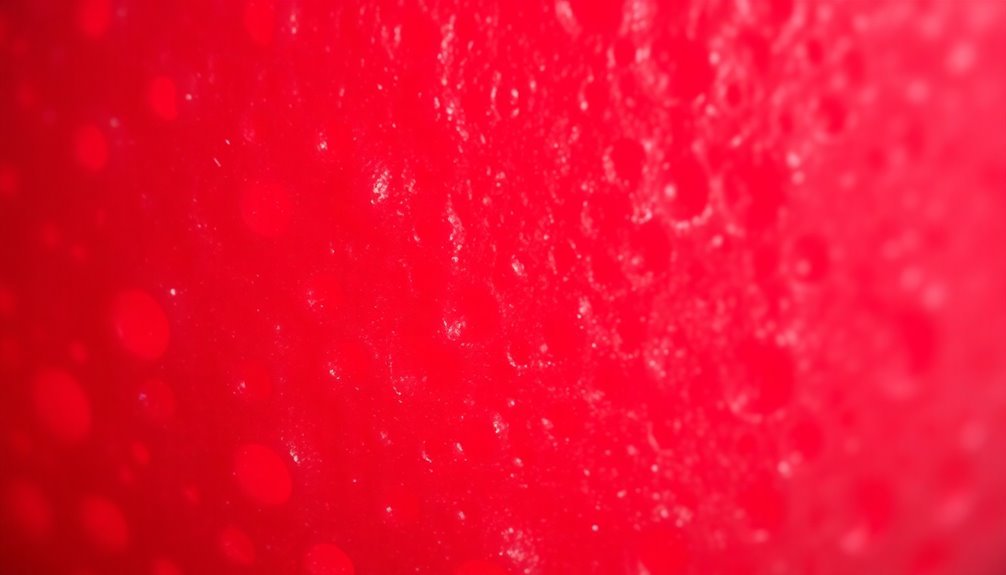
The electromagnetic spectrum encompasses a wide range of radiation types, from high-energy gamma rays to low-energy radio waves. Within this spectrum, deep wavelength radiation, particularly in the near-infrared range of 780-1400 nm, plays a vital role in skin recovery and healing.
When you're considering deep wavelength radiation treatments, you'll find they're fundamentally different from other forms of electromagnetic radiation. These longer wavelengths can penetrate deeper into your tissues, reaching muscles, cartilage, bones, and blood vessels. The radiation's intensity decreases proportionally as it travels deeper through tissue layers.
The 660 nm wavelength, in particular, has proven especially effective for skin rejuvenation.
You'll notice that wavelength and frequency are inversely related – longer wavelengths correspond to lower frequencies, while shorter wavelengths have higher frequencies. This relationship directly affects how the radiation interacts with your body's tissues.
Unlike harmful UV radiation, deep wavelength radiation doesn't damage your skin cells. Instead, it works therapeutically, stimulating natural healing processes.
Red light therapy, a common application of deep wavelength radiation, can be combined with other wavelengths to enhance its beneficial effects on your skin and underlying tissues.
The Science Behind Skin Recovery
While deep wavelength radiation offers one avenue for skin recovery, understanding the body's natural response to physical stress provides key insights into skin healing mechanisms. Your skin actively responds to exercise through increased blood flow, delivering essential oxygen and nutrients that promote cellular repair and regeneration. This natural process creates a foundation for enhanced recovery techniques.
When you exercise, your body initiates a complex cascade of healing responses. You'll experience increased blood circulation, which can make your skin appear more radiant, though temporary redness is common. Regular exercise contributes to healthier, brighter skin through improved circulation.
Your sweat glands activate to regulate temperature, but this can potentially lead to skin irritation if not properly managed.
- You'll notice immediate skin warming as blood flow increases, signaling your body's natural recovery process
- You might feel a tingling sensation as your pores open and release sweat
- You'll experience that post-workout glow as oxygen-rich blood nourishes your skin cells
- You could sense a cooling effect when properly cleansing your skin afterward
To maximize recovery, you'll need to support these natural processes with proper post-workout skincare, including gentle cleansing and hydration. Non-comedogenic products help prevent pore blockage while maintaining your skin's natural healing ability.
Cellular Energy Production
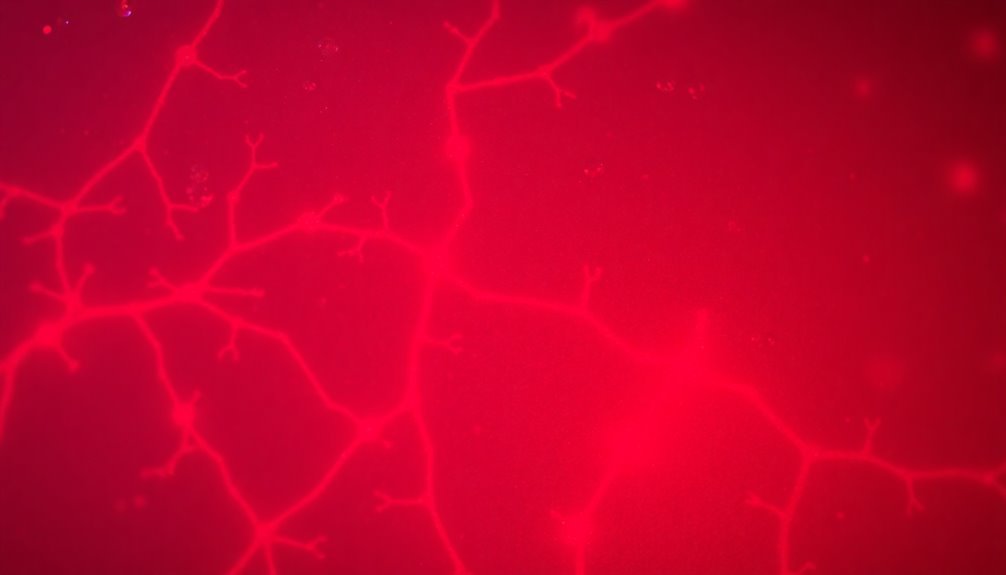
Cellular energy's intricate dance begins with ATP, your body's molecular powerhouse for skin recovery and regeneration. When your skin cells need to repair or regenerate, they rely on ATP to fuel these essential processes. Your mitochondria, the cellular powerplants, produce this crucial energy currency through cellular respiration, enabling everything from collagen production to barrier function maintenance. The absorption of infrared light by cells triggers increased metabolic activity in mitochondria.
| ATP Function | Skin Benefit | Recovery Impact |
|---|---|---|
| Energy Transfer | Powers Cell Repair | Faster Healing |
| Antioxidant Defense | UV Protection | Reduced Damage |
| Metabolic Support | Enhanced Turnover | Better Texture |
You'll find ATP's influence in every aspect of skin health, from defending against environmental stressors to supporting cellular metabolism. When your skin cells maintain high ATP levels, they're better equipped to combat signs of aging and accelerate healing processes. Deep wavelength radiation, particularly infrared and red light therapy, penetrates your skin to stimulate mitochondrial activity, boosting ATP production. This increased energy availability guarantees your skin cells can effectively carry out their repair and regeneration functions, leading to improved skin tone, texture, and overall vitality. The enhanced mitochondrial activity also promotes better blood flow and reduces inflammation through nitric oxide release.
Collagen Formation Process
Inside your skin's dermis layer, specialized cells called fibroblasts orchestrate the intricate process of collagen formation. These remarkable cells work tirelessly in your dermis, assembling amino acids into procollagen within their endoplasmic reticulum. Vitamin C is absolutely essential for this process to work properly.
The procollagen molecules then undergo a fascinating transformation as they fold into a triple helix structure, creating the foundation for strong, resilient skin.
Your skin's natural collagen formation process involves several precise steps, from DNA transcription to the final incorporation into your extracellular matrix. Enzymes play an essential role in converting procollagen into mature collagen, which then integrates into your skin's support structure.
Here's why you'll want to protect and support this important process:
- Your skin's strength and resilience depend directly on proper collagen formation
- Your youthful appearance relies on continuous collagen production
- Your skin's ability to heal and repair itself hinges on healthy collagen synthesis
- Your defense against environmental damage strengthens with robust collagen structures
Understanding this process helps explain why treatments like laser therapy can effectively boost collagen production by strategically activating your fibroblasts through controlled thermal energy.
Inflammation Response Mechanisms
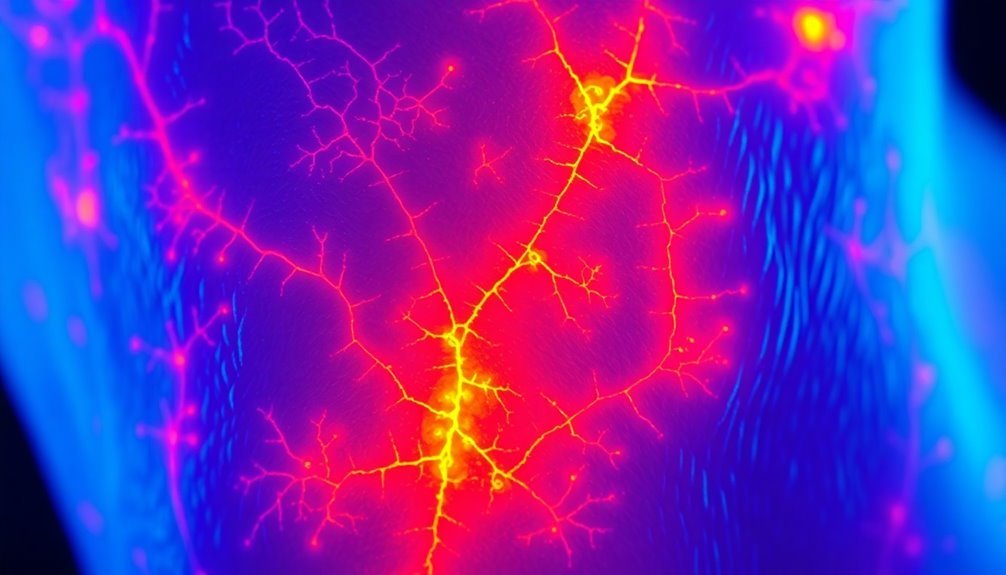
Throughout your skin's healing process, inflammation sets up a precisely orchestrated immune response. When you experience tissue damage, your body immediately launches a platelet cascade and complement system activation. Within 48-96 hours, neutrophils and monocytes arrive at the injury site, with monocytes transforming into specialized macrophages that clean up cellular debris. The transition between inflammation and proliferation requires macrophage phenotype switching from M1 to M2 states.
Your immune system's response involves multiple cell types working in harmony:
| Cell Type | Primary Action | Timeline |
|---|---|---|
| Neutrophils | Kill microorganisms | First 48 hours |
| Macrophages | Clear dead cells | 48-96 hours |
| Mast Cells | Release histamine | Throughout healing |
| T Cells | Produce growth factors | Days 2-5 |
You'll typically experience inflammation for 2-5 days as your body shifts to the proliferation phase. During this time, pro-inflammatory cytokines like TNF-α and IL-8 recruit immune cells and activate healing mechanisms. Your toll-like receptors (TLRs) trigger signaling pathways that produce essential cytokines and chemokines. If inflammation persists beyond this window, you're at risk for delayed healing, excessive scarring, and potential tissue fibrosis.
Skin Cell Regeneration Factors
Deep wavelength radiation boosts your skin's cellular ATP production and enhances mitochondrial energy, leading to faster cell regeneration and repair.
You'll notice improved skin recovery as the radiation penetrates deep into your tissue layers, stimulating the cells' natural healing mechanisms.
The increased cellular energy accelerates collagen synthesis, helping your skin maintain its structure and elasticity while promoting a more youthful appearance. This process supports natural cell turnover, allowing for continuous renewal of the skin's surface layers.
Cellular ATP Production Boost
While skin cells naturally produce ATP for various regenerative processes, boosting cellular ATP production can substantially enhance your skin's ability to repair and renew itself.
When your cells generate more ATP, they're better equipped to synthesize collagen, maintain structural integrity, and support essential skin functions. Professional microcurrent treatments can increase ATP levels by up to 500% in treated areas. This increased energy availability directly translates to improved cellular metabolism and more efficient skin recovery.
Your skin's health significantly depends on adequate ATP levels, which power vital regenerative processes and maintain fundamental cellular function. You'll experience better results from your skincare routine when your cells have sufficient energy to utilize active ingredients and carry out repair processes effectively.
- You'll notice firmer, more resilient skin as ATP powers collagen synthesis and structural protein production
- Your skin's natural healing ability will improve dramatically as cells have more energy for repair
- You'll see enhanced circulation and nutrient delivery throughout your skin layers
- Your complexion will become more radiant as cells efficiently remove waste and toxins
Microcurrent therapy and targeted skincare ingredients can help boost your skin's ATP production, leading to visible improvements in texture, tone, and overall skin health.
Mitochondrial Energy Enhancement
Understanding how mitochondria power your skin's regeneration process is essential for maintaining a healthy complexion. These cellular powerhouses convert nutrients into ATP, which fuels vital skin functions like cell renewal, wound healing, and protection against environmental damage. When your mitochondria function effectively, they support your skin's natural ability to repair and regenerate.
Deep wavelength radiation, particularly red and near-infrared light, penetrates your skin to directly stimulate mitochondrial activity. This targeted approach enhances ATP production, which accelerates tissue repair and reduces inflammation. Glycolysis increases when mitochondrial function is suboptimal, leading to less efficient energy production.
You'll notice improved circulation and faster healing when your skin's energy production is operating at peak efficiency.
To maximize mitochondrial energy enhancement, you'll need to protect your skin from excessive UV exposure while supporting it with proper nutrition and hydration. Incorporating antioxidant-rich products containing vitamins C, E, and B3 can help maintain mitochondrial health.
When combined with light therapy, these strategies work synergistically to boost your skin's energy production. The result is more efficient cell turnover, better wound healing, and enhanced protection against environmental stressors that can compromise your skin's appearance and function.
Collagen Synthesis Acceleration
Building on your skin's enhanced mitochondrial function, collagen synthesis plays a central role in maintaining skin strength and elasticity. When deep wavelength radiation reaches your dermis, it triggers a controlled thermal response that initiates collagen production through precise fibroblast activation. The degradation of dermal extracellular matrix components occurs with chronic UV exposure.
You'll experience immediate tightening as existing collagen fibers denature, followed by long-term benefits as new collagen forms.
Your skin's natural healing process accelerates when specific wavelengths (700-1200 nm) create uniform micro-injuries, prompting a sustained regenerative response. This controlled damage optimizes your skin's repair mechanisms, leading to firmer, more resilient tissue.
Here's what you'll notice as collagen synthesis accelerates:
- Your skin's texture becomes increasingly smooth and firm within weeks
- Fine lines gradually diminish as new collagen fills structural gaps
- Your complexion gains a natural, youthful bounce through enhanced elasticity
- Your skin's resistance to environmental damage improves dramatically
The process continues working even after treatment, as growth factors bind to cell receptors, maintaining healthy cell turnover and structural protein production. This ongoing regeneration helps combat signs of aging while strengthening your skin's natural defensive barriers.
Deep Tissue Penetration Benefits
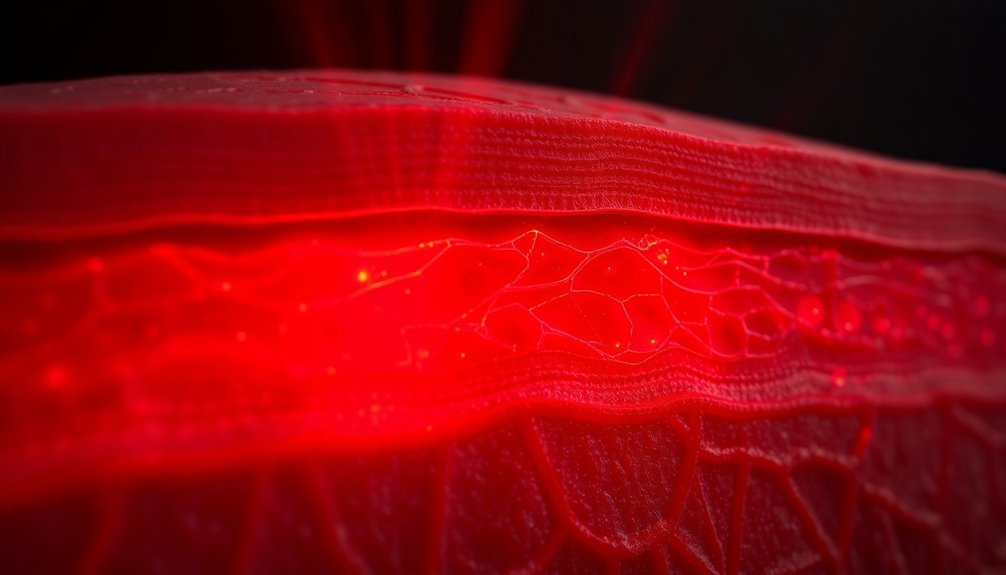
Low-wavelength red light enters multiple skin layers to activate cells at varying depths, from the surface epidermis down to deep dermal tissues.
You'll notice increased cellular activity as the light stimulates mitochondria, your cells' power plants, leading to enhanced energy production and improved cellular function.
This depth of penetration allows for thorough tissue regeneration, as cells throughout different skin layers receive the energizing benefits of the therapy. The therapy triggers fibroblast production activity, which is essential for creating new collagen and maintaining skin structure.
Cellular Activation Depth Levels
Wavelength selection plays a crucial role in determining how deep radiation penetrates skin tissue during therapeutic treatments. You'll find that shorter wavelengths between 200-400 nm barely penetrate the skin, while longer wavelengths of 630-730 nm reach deeper tissue layers, making them ideal for photodynamic therapy.
The sweet spot for maximum penetration lies between 900-1000 nm, with GaAs lasers operating at 904-905 nm proving particularly effective.
Your skin's response to different wavelengths varies markedly, which is why specific frequencies are chosen for distinct therapeutic purposes. For instance, you'll experience different effects at:
- 5 Hz – Triggers deep tissue regeneration, activating your body's natural healing processes
- 50 Hz – Delivers powerful anti-inflammatory effects, reducing pain and swelling
- 630-730 nm – Stimulates photodynamic therapy responses in targeted skin layers
- 904-905 nm – Enables superpulsing for deep tissue penetration while maintaining comfortable power levels
When combined with advanced techniques like RadioPDT and nanomaterial-enhanced delivery systems, these precisely chosen wavelengths can dramatically improve your skin's recovery potential, especially when treating complex conditions or targeting specific tissue depths.
Enhanced Mitochondrial Energy Production
Therapeutic light penetration triggers a remarkable cascade of cellular energy production in your deep tissue layers. When near-infrared (NIR) light reaches your cells, it stimulates your mitochondria to produce more ATP, which powers cellular regeneration and repair processes. This enhanced energy production directly impacts your skin's ability to heal and rejuvenate.
You'll experience multiple benefits from this deep tissue penetration. The NIR wavelengths can reach your muscles and bones, reducing inflammation throughout the affected areas while providing significant pain relief.
As your cells receive this energy boost, they accelerate tissue renewal and repair processes, leading to more efficient healing.
Your skin's recovery is further enhanced by the combination of different radiation types. While infrared radiation promotes wound healing, red light therapy stimulates collagen production for improved skin structure.
These therapeutic doses work together to optimize your skin's natural healing mechanisms without causing thermal damage. The process is distinctly different from other treatments like radiofrequency or microneedling, as it focuses specifically on enhancing your cells' energy production rather than creating controlled damage to trigger healing responses.
ATP Production and Healing
Because skin cells rely heavily on energy for repair and regeneration, ATP serves as the fundamental power source driving cellular healing processes.
When deep wavelength radiation penetrates your skin, it triggers enhanced ATP production within the mitochondria of your cells, accelerating the natural healing mechanisms that restore damaged tissue.
Your skin's ability to produce ATP directly impacts its recovery potential. Through the process of photobiomodulation, light energy is absorbed by cell membranes and mitochondria, stimulating ATP synthesis and boosting cellular metabolism. This increased energy availability enables faster wound healing, collagen production, and tissue repair.
- You'll experience improved wound healing as ATP delivery enhances macrophage accumulation and strengthens tissue
- Your skin's elasticity will increase through enhanced collagen and elastin production
- You'll notice faster recovery from damage as ATP powers cellular regeneration
- Your aging symptoms will diminish as increased ATP counters the effects of reduced cellular energy
Understanding ATP's role in skin recovery explains why treatments like low-level laser therapy are so effective. By targeting the cellular powerhouses – mitochondria – these therapies optimize your skin's natural healing capabilities through enhanced ATP production.
Free Radical Defense Systems
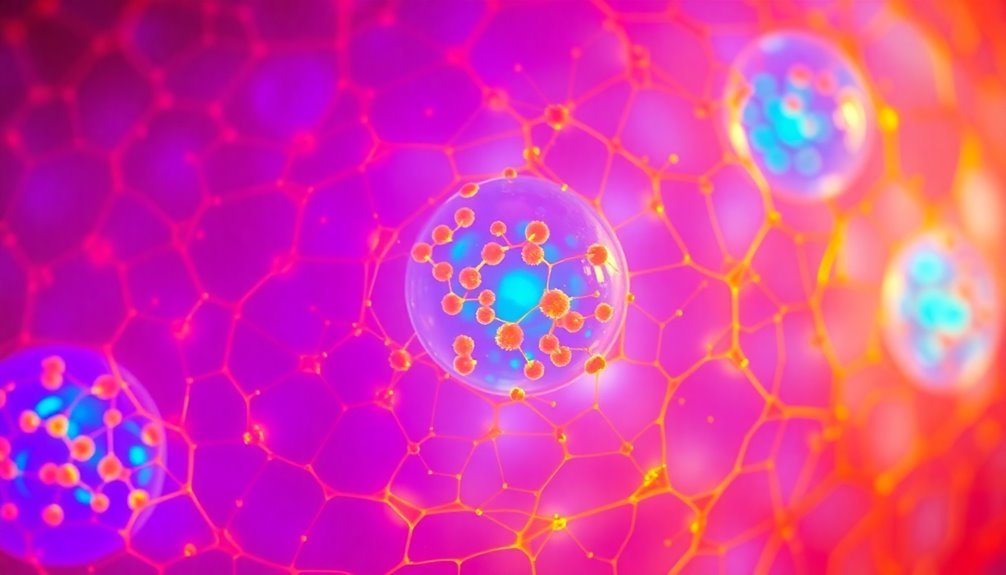
While ATP production powers cellular repair, your skin simultaneously battles another challenge: free radicals. These unstable molecules, generated by UV radiation, pollution, and internal metabolic processes, can wreak havoc on your skin's structure and function.
They're particularly destructive to collagen and elastin, leading to premature aging and compromised skin barrier function.
Your body's natural defense system includes both direct and indirect antioxidants that work to neutralize these harmful molecules. Plant polyphenols, such as resveratrol and quercetin, play a vital role in counteracting cellular senescence, while vitamins like vitamin C actively capture free radicals before they can cause damage.
You'll also find that your body produces its own antioxidants, though these can become overwhelmed by excessive oxidative stress.
To strengthen your skin's defense against free radicals, you'll need a multi-faceted approach. This includes using antioxidant-rich skincare products, maintaining a diet high in fruits and vegetables, and managing stress levels.
When combined with deep wavelength radiation therapy, these strategies create a powerful shield against oxidative damage while supporting your skin's natural repair mechanisms.
Treatment Safety and Guidelines
Safety protocols for deep wavelength radiation treatments require careful attention to protect your skin and eyes during therapy sessions.
You'll need to wear protective goggles to prevent potential eye damage, and you should always follow the device manufacturer's instructions precisely.
While red light therapy is generally safe for short-term use, misuse can lead to skin damage, blistering, or more serious complications.
Professional guidance is critical before starting any treatment regimen. You'll find that home devices typically deliver less power than professional equipment, which may affect your results.
When using these treatments, you must adhere to recommended exposure times and frequencies to avoid adverse effects.
- Don't let the promise of quick results tempt you into overexposure – your skin's health isn't worth the risk.
- Remember that every treatment session brings you closer to your skin recovery goals when done safely.
- Trust in the power of patience – rushing the process could compromise your results.
- Take pride in following proper safety protocols – they're your shield against potential complications.
If you experience any skin redness or irritation, stop treatment immediately and consult a healthcare professional.
The long-term effects of this therapy aren't fully understood, so maintaining cautious and consistent monitoring is essential.
Clinical Research Findings
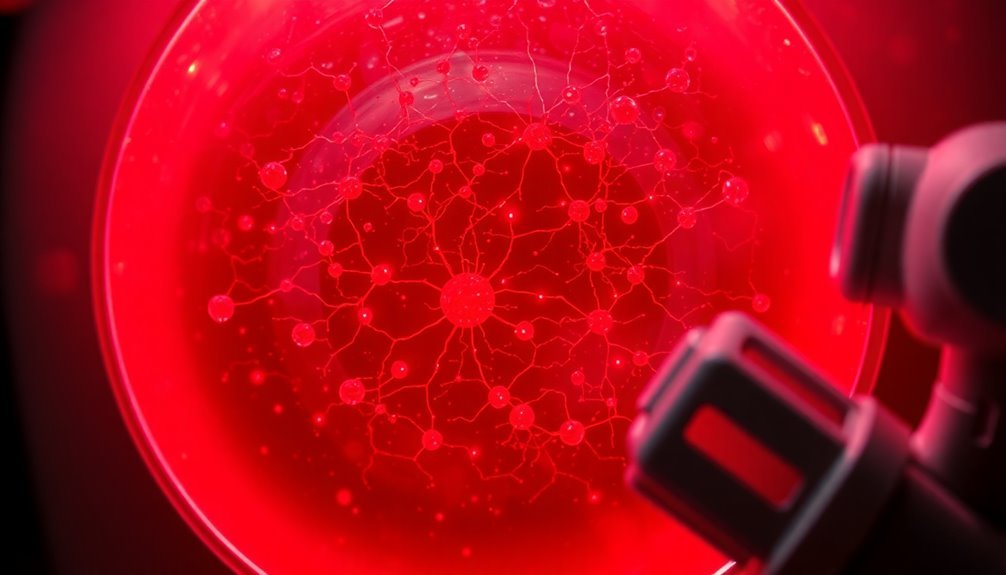
Research studies have shown that near-infrared light therapy (800-830 nm) cuts healing time by 12 days, while red light therapy (630-680 nm) reduces recovery time by an impressive 19 days.
You'll find strong evidence supporting photobiomodulation's effectiveness in treating radionecrosis and promoting tissue repair through TGF-beta 1 activation and enhanced blood flow.
Clinical trials demonstrate consistent success rates in managing both brachytherapy and teletherapy-related skin damage, with documented improvements in inflammation reduction and wound healing acceleration.
Evidence From Major Studies
Leading clinical studies examining deep wavelength radiation's impact on skin recovery have produced mixed results. While research shows promising mechanisms like increased collagen production and enhanced cellular energy, the clinical evidence for preventing radiation-related skin damage remains limited.
Meta-analyses reveal that light therapy offers minimal benefits in preventing radiation dermatitis, with only low-certainty evidence suggesting reduced rates of severe cases.
You'll find these key findings particularly striking:
- Your skin's response to radiation treatment depends primarily on the dose and area exposed, not necessarily on light therapy intervention.
- Your body's natural healing process may benefit from light therapy's ability to boost blood circulation and reduce inflammation.
- You won't see significant differences in moderate skin reactions whether you use light therapy or placebo treatments.
- Your skin pain levels during radiation therapy aren't consistently reduced by light therapy applications.
The most reliable evidence supports standard skin care practices, such as gentle cleansing, over light therapy for radiation dermatitis prevention. However, light therapy's ability to enhance cellular energy and promote new blood vessel formation suggests potential benefits for general wound healing, even if its preventive effects are limited.
Treatment Duration Statistics
While earlier studies focused on effectiveness, the actual duration of radiation skin recovery provides compelling insights into treatment outcomes.
Without photobiomodulation, you'll find that radiation skin injuries take approximately 61 days to heal, and in severe cases, recovery can extend beyond a year. Late effects can manifest months or even years after exposure, making long-term monitoring essential.
You'll see significant improvements when using photobiomodulation therapy. Near-infrared light therapy reduces healing time to 49 days, while red light therapy shows even better results at 42 days – that's up to a 50% acceleration in recovery. This improvement stems from photobiomodulation's ability to trigger cellular processes that control inflammation and tissue regeneration, particularly through TGF-beta 1 activation.
The severity of radiation skin injury directly relates to the dose received. You'll notice that doses above 20 Gy can cause severe damage, including ulceration and necrosis, while lower doses between 6-20 Gy typically result in milder symptoms like erythema and hyperpigmentation.
Treatment planning considers these factors through fractionation, which helps minimize toxicity while maintaining therapeutic effectiveness.
Documented Recovery Rates
Through extensive clinical trials, documented recovery rates consistently demonstrate photobiomodulation's remarkable impact on radiation-damaged skin. You'll find that red light therapy achieves complete healing in just 42 days, while near-infrared therapy takes 49 days – both markedly outperforming traditional treatments that require 61 days.
The cellular response to these deep wavelength treatments triggers powerful healing mechanisms, activating TGF-beta 1 and stimulating essential collagen production.
Clinical research has revealed compelling recovery statistics that showcase the therapy's effectiveness:
- 50% faster healing rates for radiation-damaged skin when treated with light therapy
- Noteworthy reduction in inflammation markers and pain levels within the first treatment sessions
- Enhanced mitochondrial function leading to accelerated cellular repair and regeneration
- Consistent improvement in skin integrity without adverse effects on cancer treatment outcomes
You'll notice these improvements stem from photobiomodulation's ability to trigger specific cellular processes that control inflammation and tissue regeneration. What's particularly noteworthy is that these benefits occur without interfering with cancer treatments, as tumor cells don't respond to PBM in the same way as healthy tissue.
Wavelength Effects on Skin
Different wavelengths of light interact uniquely with human skin, producing both beneficial and harmful effects. While UV radiation can damage your skin by breaking DNA bonds and generating harmful reactive oxygen species (ROS), certain wavelengths offer therapeutic benefits for skin recovery.
You'll find that visible light and UV affect your skin differently. UV penetrates less deeply but causes more direct damage, leading to sunburn and potential skin cancer.
Visible light reaches deeper into your dermis and, at specific wavelengths, can actually promote healing. Red light (600-700 nm) and near-infrared (770-1200 nm) wavelengths are particularly effective at stimulating wound recovery.
Your skin's natural protection comes primarily from melanin, which acts as a filter against both UV and visible light. If you have darker skin, you'll have better natural protection due to larger, more dispersed melanosomes.
However, you'll need additional protection, as even beneficial wavelengths can cause damage at high doses. That's why modern sunscreens are beginning to offer broader spectrum protection beyond just UV blocking, addressing the complete range of solar radiation effects on your skin.
Frequently Asked Questions
Can Deep Wavelength Therapy Be Combined With Regular Skincare Products?
Yes, you can combine deep wavelength therapy with skincare products. Just remove makeup and sunscreen before treatment, then use products with vitamin C, retinol, or peptides afterward to enhance your results.
How Long Should Someone Wait Between Deep Wavelength Treatment Sessions?
You'll need to wait 3-7 days between deep wavelength treatments to prevent skin irritation and allow proper healing. Your provider will determine your exact interval based on your skin's response and treatment goals.
Does Skin Color or Thickness Affect the Treatment's Effectiveness?
Yes, your skin color and thickness substantially affect treatment results. You'll need higher doses with darker or thicker skin since they reduce light penetration. You should adjust treatment intensity for maximum effectiveness.
Are There Any Specific Foods That Enhance Deep Wavelength Therapy Results?
You'll enhance therapy results by eating collagen-boosting foods like lean meats and citrus fruits, plus blood flow-promoting options such as watermelon and pomegranate. Antioxidant-rich berries and leafy greens are also beneficial.
Can Deep Wavelength Therapy Help With Old Scars and Stretch Marks?
Yes, you'll see results with old scars and stretch marks through deep wavelength therapy. It stimulates collagen production and enhances tissue regeneration, making both old scars and stretch marks less visible over time.
In Summary
You'll find deep wavelength radiation boosts skin recovery through multiple mechanisms. It penetrates deeply into your tissue, stimulating cellular energy production and enhancing collagen formation. When you use this treatment, it activates your body's natural healing processes, reduces inflammation, and strengthens your free radical defense systems. Research shows it's a safe, effective method when you follow proper guidelines and wavelength specifications.
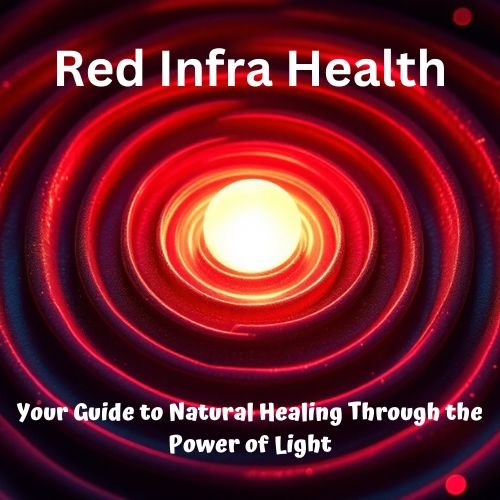
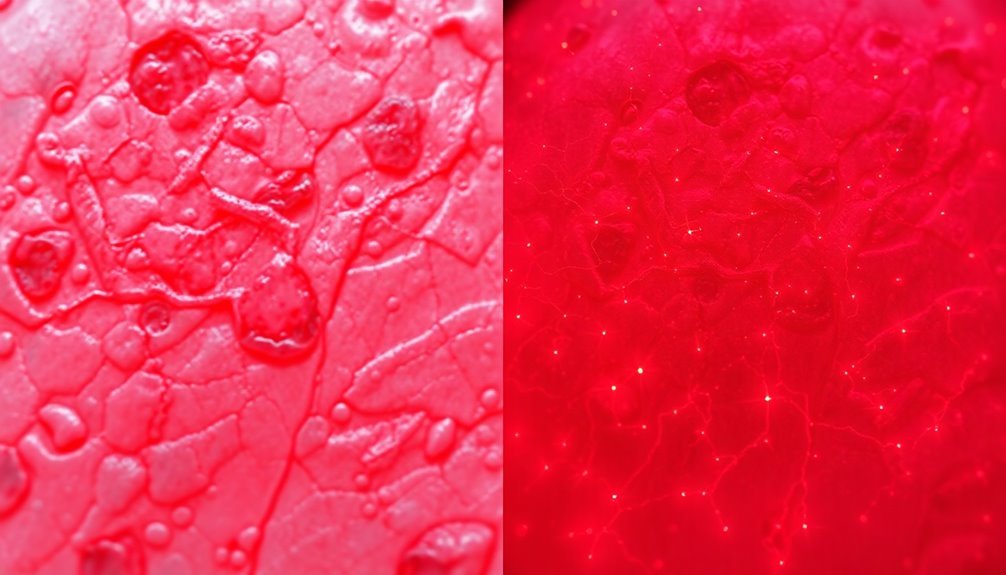



Leave a Reply